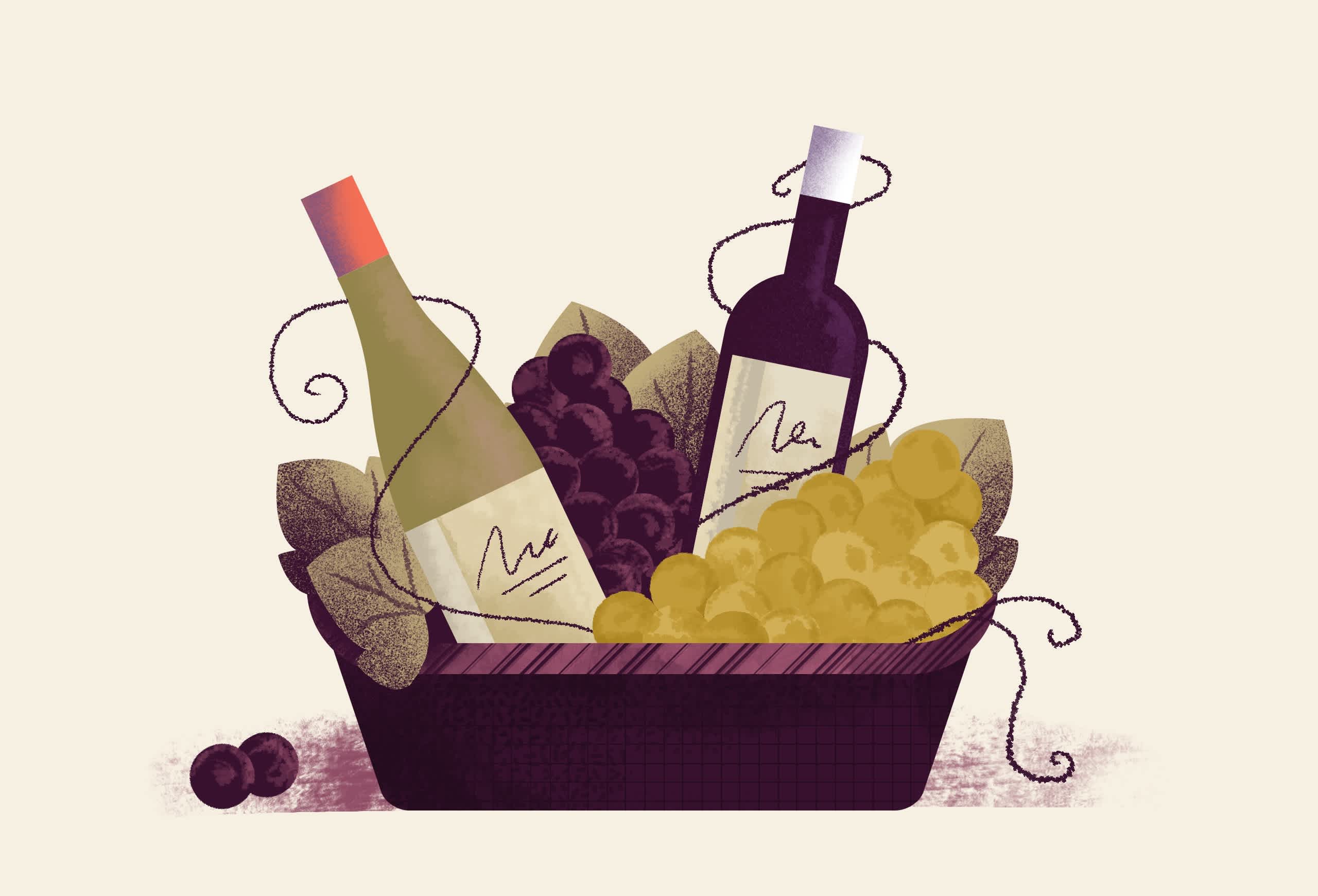The Different Types of Wine Grapes
Learn about what makes wine grapes special and a little bit about some of the most popular varietals
In winemaking, not all grapes are created equal. The quality of a wine comes directly from the quality of the ingredients, and the skill and vision of a winemaker.
The basic building block of wine, the grape, comes in an incredible array of colors and interesting characteristics. What we know of as "wine grapes" almost all come from one species of vine: Vitis Vinifera. The grapes that come from these grapevines were born in the old world and have interbred to give us the varietals that we know and love today. They can be used for winemaking or for eating as raisins or regular "table" grapes.
Each grape has it's own unique qualities, and when paired with the right soil and an attentive winemaker, good grapes can produce something unique and worth seeking out.

Take Our Quiz Today
Get award-winning delicious wines from all over the world shipped straight to your door. Take the quiz to get the perfect pairings for your holiday season.
Take The Quiz TodayIN THIS ARTICLE:
Vitis Vinifera
There are at least 5,000 Vitis Vinifera grapes varieties and possibly many thousands more, but the large majority of wine comes from just a few grapes. Popular grapes rule the wine store shelves, and you'd be hard-pressed to find a wine drinker that didn't know about Cabernet Sauvignon, Chardonnay, Merlot, Pinot Noir, Sauvignon Blanc, Syrah/Shiraz, and Riesling. These "International Varieties" gained traction in the last few decades of the 20th century and were planted in wine regions all over the world. At the time they were thought to make excellent wines no matter where they were planted, but that wasn't always the case. Many of the resulting wines paled in comparison to the ones they were trying to emulate.
Recently we have seen winemakers returning to indigenous varietals. It's an exciting time to be a wine lover as we have access to more and more new types of wine, while still being able to access terroir-driven examples of our favorite grapes.
What Makes Wine Grapes Special
While some wine grapes can be consumed, there are certain characteristics that winemakers look for in their grapes. The most important difference is that wine grapes have higher acidity. High acidity provides balance in the flavor profile and effects a wine's aging potential. Most table grapes don't have this acidity and are much sweeter and easier to eat. While you could theoretically make wine with these grapes, it wouldn't result in a balanced wine.
Does Color Matter for a Wine Grape?
Grape varieties come in all manner of colors. But have you ever crushed a red grape before eating it? The juice from red grapes runs clear. So where does the red color in wine come from? The answer lies in the grape's skin.
Grape skins contain the pigments that give the wine it's color, tannins, texture, and more. White wines, made from white grapes don't usually spend time with the grape skins after they've been pressed. That's why many white wines are light in texture, color, and have no tannins. Oak can add some of the components (see: oaky Chardonnay) that a white wine originally lacked. Some ancient techniques have become popular again and we are starting to see more orange wines (white wines fermented with the skins that lightly color the wine and add texture).
Red wines spend time on the skins at the beginning of the winemaking process. The length of time spent with the colored grape skins can determine the final color of a wine. Light pink rosés sit in stark contrast to inky dark Syrah/Shiraz wines. Simply put, Syrah is a grape that has robust pigment tannins that result in deep, dark wines. Needless to say, the color and texture provided by the grape skins are vitally important and are the canvas for a winemakers palette.
Wine Grape Variety Guide
As we said before, there are thousands and thousands of grape varietals, so we are focusing on the most common to the Firstleaf wine club and to the great wine world at large. Click the links to learn even more about a grape. Other great resources for all the information you could want on most grape varietals are Oz Clarke's fantastic book Grapes & Wine as well as Jancis Robinson's The Oxford Companion to Wine.
Red Wine Grapes
Barbera is a late-ripening red grape known for its ability to suit a winemaker's needs in the Piedmont region of Italy and in a few select regions of the new world.
Cabernet Franc is a rustic grape with small berries and thick skins that is used to add complexity and texture to blends from Bordeaux, but is also used to make amazing single varietal wines in the Loire Valley.
Cabernet Sauvignon is often called "King Cab," because of its dominance in acreage. It's grown in almost every region on Earth with some of the best examples coming from Napa Valley and Bordeaux.
Carménère is a low acid, sweet grape that is largely found growing in Chile.
Grenache is a late-ripening, thin-skinned grape that is often found in blends from all over the world with concentrations in the Rhône Valley, Priorat, Southwest Australia, and Washington State.
Malbec is a rich, spicy red that thrives in the vineyards of Argentina and Cahors, France.
Merlot is one of the most planted varietals on earth and is known for making wines that are low in tannins and big in fruit flavor.
Mourvèdre is a Spanish grape thrives in southern France, particularly in the Rhône Valley and Bandol on the Mediterranean coast.
Nebbiolo is a grape the makes up the "Wine of Kings" also known as Barolo in the Piedmont region of Northwest Italy.
Petite Sirah is a rustic grape that has found a new lease on life all over the New World.
Petit Verdot is a late-ripening grape that rounds out the blends of Bordeaux.
Pinot Noir is a finicky grape that produces some of the finest (and most expensive) wines on earth with fantastic examples coming from Burgundy, and increasingly from Oregon.
Sangiovese is a thin-skinned grape that is high in both acidity and tannins, and is the most at home in the Chianti region of central Italy.
Syrah/Shiraz are two names for the same grape, but refer to vastly different styles of winemaking.
Tempranillo is known by many other names, but makes incredibly fine wines throughout the Iberian Peninsula.
Zinfandel, which is sometimes known as Primitivo, sprang to stardom in California before tracing its roots back to southern Italy and then to Croatia.
White Wine Grapes
Airén is the most planted white grape varietal in the world, but is used most often for fortified wines.
Chenin Blanc is a lovely white grape that can be used to make many styles of wine from complex examples in the Loire Valley to the fortified wines of South Africa.
Chardonnay is the most famous, and contentious, white wine grape. It can be crisp and mineral-driven or it can be oaky and buttery depending on the wishes (and skill) of the winemaker.
Gewürztraminer is a lovely, aromatic grape that makes wines full of spice and flowers.
Grüner Veltliner is Austria's signature grape and makes delightful, easy-drinking wines as easily as it makes complex, textured versions.
Muscat/Moscato is known for a pronounced floral aroma in the bouquet, ripe fruit, and the ability to be made in a variety of styles.
Pinot Grigio/Pinot Gris is another white grape that is used to make multiple styles that range from crisp and citrusy to floral, textured, and complex.
Riesling is a favorite of sommeliers everywhere and can make some of the most complex wines on earth with the best examples coming from Germany, Alsace, and even some from New York.
Sauvignon Blanc is a fantastic grape that exhibits unique characteristics, especially in examples from New Zealand.
Viognier is a white grape that is often added to blends to give texture and complexity, and even is used to help round out some red wines.
IN THIS ARTICLE

WinePrint™ by Firstleaf
Are you looking to learn more about your wine preferences? Check out our Wine Print for an in-depth look at your personal tasting profile. Discover your favorite wines, varietals, regions, and tasting notes and get personalized recommendations wherever you are.
Learn More